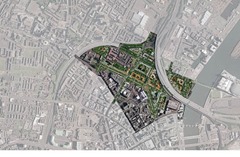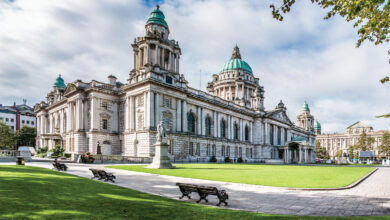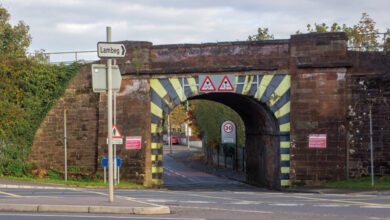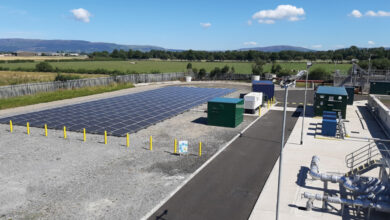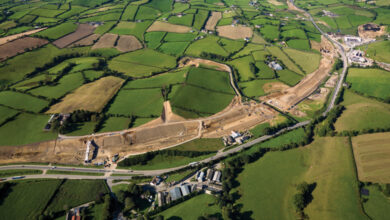Revising the Masterplan
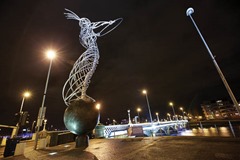 An updated blueprint for Belfast’s development places a high importance on the city centre and sharing the benefits of new investment with deprived communities. Peter Cheney reports.
An updated blueprint for Belfast’s development places a high importance on the city centre and sharing the benefits of new investment with deprived communities. Peter Cheney reports.
The 2004 Belfast City Masterplan was published after almost 40 years of conflict and anticipated a time of continued economic growth. SLR Consulting Ltd’s review of the Masterplan now comes against a backdrop of a prolonged economic downturn and covers a more uncertain period, leading up to 2020. Input on economics and transportation was provided by Oxford Economics and SKM Colin Buchanan.
While quality of life has improved in commuter settlements during the boom years, deprivation within Belfast remains “largely unchanged”. Quality of life is a cross-cutting theme in the revised Masterplan and takes health, education, community safety, employment and the environment into account.
The Masterplan, which will soon be consulted upon, sets out six objectives:
• the learning city;
• the accessible and connected city;
• the low carbon city;
• the digital city;
• the centre city; and
• the neighbourhood city.
A ‘learning city’ will both harness the economic power of its higher and further education institutions and also raise the low levels of attainment in deprived communities. The University of Ulster’s relocation is a key part of this work and will enhance the existing education assets of the city including Queen’s University and Belfast Metropolitan College.
The ‘accessible and connected’ theme refers to the Belfast Rapid Transit project and also recognises the role of the port and two airports in reaching export markets.
Sustainable energy and low carbon technologies are highlighted as market opportunities in the Executive’s Economic Strategy. There is also “considerable scope” for reducing Belfast’s carbon footprint.
Existing broadband networks give Belfast an advantage as a ‘digital city’ and this will be enhanced by a £13.7 million contribution from the UK Government’s Super-connected Cities project.
The concept of a city region also needs to take root, the authors say. Belfast’s economic geography “extends well beyond its current administrative boundaries” but the Regional Development Strategy, in their view, “fails to fully capture the unique dynamics of the city” and misses the opportunity to fully identify priorities for growth. They therefore call for a specific urban policy to cover the Belfast city region.
The ‘centre city’ area runs from Queen’s University to the Titanic Quarter. This must be “accessible, vibrant, attractive and dynamic” in order to drive regional growth. This is the “economic, social and cultural heart” of the city and its wealth provides for public services across the rest of Belfast.
“Attractive connected neighbourhoods are a feature of all successful cities,” the review adds. High quality environments and a mixture of housing types and tenures should bring new residents into the city.
Speaking at the conference, SLR’s Technical Director Paul McTernan warned that Belfast city centre was running out of Grade A office space. Several office buildings (e.g. Lanyon Towers) are currently vacant but once these are filled, the city will have no more high quality office accommodation to offer investors.
SLR has emphasised the importance of concentrating office and retail development in the city centre and developing the area’s attraction as a place to live. The role of the city centre needs to be protected and enhanced. Expanding Belfast Waterfront for additional conference facilities could potentially bring another £40 million per year of spend into the city.
The city centre needs to consolidate two key areas that link it with the university area to the south and the Titanic and harbour area to the north. These are identified in the Masterplan as Cathedral (above) and Shaftesbury Link (described overleaf). The opportunity to plan for a new university campus is described in the Masterplan as a ‘once in a century’ event. The successful integration of the University of Ulster into the Cathedral Quarter will be essential to link the site fully within the city’s urban fabric, providing a significant boost to the north city centre area.
This is just one of several projects for this part of the city which need to be aligned with each other. Others include the upgraded motorway interchange at York Street, the Royal Exchange development, the North Belfast Cultural Corridor and turning Dunbar Link, Great Patrick Street and Frederick Street into tree-lined urban avenues.

